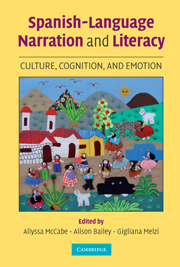Book contents
- Frontmatter
- Contents
- List of Contributors
- Preface
- Acknowledgments
- 1 Introduction
- PART ONE PARENT–CHILD NARRATIVES
- PART TWO DEVELOPING INDEPENDENT NARRATION
- PART THREE NARRATIVE LINKS TO LITERACY AND OTHER SCHOOL ACHIEVEMENTS
- 11 Latino Mothers and Their Preschool Children Talk About the Past: Implications for Language and Literacy
- 12 The Contribution of Spanish-Language Narration to the Assessment of Early Academic Performance of Latino Students
- 13 Cultural Variation in Narrative Competence and Its Implications for Children's Academic Success
- Author Index
- Subject Index
- References
11 - Latino Mothers and Their Preschool Children Talk About the Past: Implications for Language and Literacy
Published online by Cambridge University Press: 05 June 2012
- Frontmatter
- Contents
- List of Contributors
- Preface
- Acknowledgments
- 1 Introduction
- PART ONE PARENT–CHILD NARRATIVES
- PART TWO DEVELOPING INDEPENDENT NARRATION
- PART THREE NARRATIVE LINKS TO LITERACY AND OTHER SCHOOL ACHIEVEMENTS
- 11 Latino Mothers and Their Preschool Children Talk About the Past: Implications for Language and Literacy
- 12 The Contribution of Spanish-Language Narration to the Assessment of Early Academic Performance of Latino Students
- 13 Cultural Variation in Narrative Competence and Its Implications for Children's Academic Success
- Author Index
- Subject Index
- References
Summary
Key words: narration, Latino children, parent–child reminiscing, reminiscing style, language development, literacy
ABSTRACT
This chapter explores the ways that Latino mothers and their preschool children reminisce. Parent–child conversations about past events were examined for level of maternal elaboration, and children's independent narratives were analyzed for the presence of elements that are thought to characterize Latino children's narrative forms. A qualitative analysis of talk between a single mother and her child was undertaken to examine other possible strategies that Latino caregivers use to engage their children in conversations about the past. The relationship between maternal elaboration and the child's provision of contextualizing elements in independent narration points to talk about misbehavior as a culturally salient context for reminiscing. Implications for developing narrative structure and literacy in the preschool classroom are discussed.
INTRODUCTION
Recounting the day's events at dinner, telling stories about a summer vacation, detailing the events that led to an emergency room visit – all are forms of talk that occur in family conversation. From the earliest age, children learn to tell tales that are valued by those among whom they live and grow (Miller, Potts, Fung, Hoogstra, & Mintz, 1990), they come to recognize rhetorical patterns that occur regularly in the chatter they hear daily (Heath, 1986), and they become skilled narrators of personal stories in ways that are recognizable to those with whom they talk (Hymes, 1972).
- Type
- Chapter
- Information
- Spanish-Language Narration and LiteracyCulture, Cognition, and Emotion, pp. 273 - 295Publisher: Cambridge University PressPrint publication year: 2008
References
- 7
- Cited by



